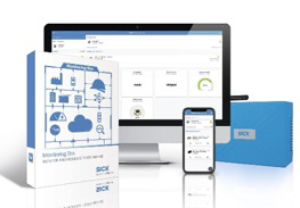
Posted to News on 3rd Nov 2021, 00:00
A bite-sized route to digital integration
Everybody’s talking about digital transformation. And, just like the elephant that must be tackled one bite at a time, it seems an overwhelmingly huge process for any manufacturer to swallow in one go. Seb Strutt, Senior Product Manager with SICK UK, plots a bite-size route to real-world Industry 4.0 integration with data at its heart, and ditches the buzz words in favour of simple, quick and practical use-cases.

From Zoom meetings to e-commerce, the business imperatives of a pandemic have provided fertile ground for an unprecedented acceleration in digitalisation. A great deal of competitive upheaval has ensued. The more successful businesses have thrived by radically shrinking the time taken to achieve added-value gains in efficiency.
Countless strategy gurus, seminars and lead articles are telling us daily that businesses need the courage to radically rethink their technology, people and processes to transform to a digitalised operation.
At SICK, we know from first-hand experience just how challenging it can be to take an existing factory and digitalise it. There is fixed infrastructure, established machinery and controls, and a host of paradigms embedded in existing procedures, processes, and culture that make it hard to separate wants from needs. Unless you have the luxury of starting from scratch with a smart factory blueprint, you can find yourself rapidly heading down a digital wormhole.
Steps to digital maturity
This rapidly changing landscape has transformed SICK’s business, too, in an astoundingly short time. Historically, SICK has been a manufacturer of ‘blue and yellow boxes’ – sensors. Now we are a supplier of software and digital services that work to solve individual, real-world business problems.
For those of us well-drilled at extolling our sensors’ latest technical features, it is prompting a new way of thinking. Our users may not really bother how, or why, a sensor works like it does; what they want is information. Our job is to make as easy as possible for them to access, transmit and interpret it.
Data is the hero
Data is the hero of this story, and sensors are the means to acquire it. The steps to digital maturity are about recognising and exploiting data to make machines and processes more efficient and agile, as well as to inform higher-level business management decisions.
I like to use this example of testing blood sugar levels in diabetes. Only a few years ago, a diabetic would use a finger-prick blood test, several times a day, to get a single data point reading from a stand-alone meter. Now, with a sensor permanently on their arm, a diabetic can read out continuous data on a smartphone or watch and visualise the all-important upwards or downwards trends. The graph automatically plots a future course, enabling corrective action to be taken before a potentially life-threatening hypoglycaemic reaction occurs.
The next step in the technology, already in clinical trials, is an automated closed-loop ‘artificial pancreas’ system. This will use artificial intelligence to process data from the blood glucose sensor to predict the patient’s requirements and automatically manage the dosage of the insulin pump in real time. This simple but powerful example of steps to digital maturity is much the same as the journey to Industry 4.0 in factory and logistics automation.
The process of computerisation and connectivity have been familiar to us for many years. Now the first step in the development of an Industry 4.0 operation is the visibility to see what is going on. Next, is the transparency to understand and interpret the data. Often aided by visualisation, as in the diabetes example, we also gain a highly value-added capacity to predict what will happen next. Finally, we will use that data to automate responses, most likely deploying AI, to enable processes to self-optimise and adapt in real time.
Starting with sensors
But where to start? How do we break down this elephant into bite-size pieces? As a sensor company, SICK sees the data generated using sensors in individual machines, linked plants, or entire factories, as the foundation for Industry 4.0 solutions.
Crucially, we believe many of these digital interventions can happen without changes to production infrastructure and without interfering with existing machinery and controls: Simply bolt on the sensor, a data transmission gateway, and use edge computing power to retrofit true added value through digitalisation.
Of course, those sensors may record many status parameters, from simple presence to distance measurements, to temperature, level, location, humidity, flow or vibration. An IIoT gateway transmits the digitalised data to a cloud-based platform or higher-level management system, such as MES or ERP. Thus, the operative technology level (OT) is connected to the IT world, enabling visualisation, predictive capability and even self-determining machine automation.
The business value outcomes are also different each time. The objective may be to better anticipate customer demand or the needs of the supply chain, to inform more efficient production processes or, ultimately, to make operations more agile and adaptable.
Typical use cases
To demonstrate how simple, rapid and relatively low-cost this process can be, let’s look at some typical customer use cases. Although the product and processes may be different, the requirements are remarkably universal. They are real-world examples you can replicate or adapt.
Use case 1 – Energy usage monitoring: Our customer approached us to find out if, where, and by how much, compressed air leakage was leading to wasted energy costs across the production facility. How could the energy loss be identified and prevented without frequent, costly external assessments?
SICK deployed its smart FTMg Flow Meters at strategic points around the plant, together with a SICK Telematic Data Collector gateway to collect and pre-process the desired data. The desired data could be visualised in real time via the SICK Monitoring Box platform, with pre-set alerts, alarms, and maintenance recommendations. In this way, it was also possible to monitor the condition of the plant itself and predict any issues. As a result, the load on multiple compressors could also be adjusted in real time to mitigate the pressure loss on various parts of the system and minimise energy demand.
Use case 2 – Monitoring fill levels: Our customer’s operation erected cartons for a food and beverage packing line using well-established machinery. They wanted to streamline production and save costs by reducing the number of operators needed to replenish the filling magazines of several machines. It was identified that while one person could, in theory, fill multiple machines, sometimes two machines required filling at the same time, so multiple operators had to be employed.
The solution used smart SICK DT50/DT35 distance sensors to monitor the magazine stack height, alongside other data from the existing machinery that the customer requested. Data was acquired by OPC-UA or the SICK sensors and transferred via a SIM1012 edge gateway to the SICK LiveConnect platform in the cloud. A sequence of fill-level warnings is then displayed on smart wristwatches worn by the operators. Meanwhile, all the data collected could be visualised and monitored on a dashboard by management personnel. As a result, some operators were deployed to other tasks, and the operation managed more efficiently.
Use case 3 – Machine availability monitoring: Our customer wanted to assess the capacity of its shop floor CNC machines before taking a decision to invest in new equipment. The run time per day of each machine was not known, and finished items were counted manually, with the resulting opportunity for human error.
Our solution entailed fitting several data sources to each machine: inductive sensors, compressed air status and even machine status ‘traffic light’ lamps, connected via an edge gateway and visualised in a cloud-based dashboard.
The customer was surprised to find that, on the first two lines analysed, one had an unexpectedly lower average production rate than was thought. As well as a host of requested operating data, a calculation of Overall Equipment Effectiveness (OEE) could also be automatically monitored in real time. So, from a few simple sensors, a continuous measure of production efficiency resulted, which added value far beyond the original expectation.
Remarkable, simple and rapid
It’s clear that the use cases described are remarkably simple and universal. Yet all were transformative. Equally, each delivered significant added value, quick and simple deployment, with some impressive returns on investment.
We believe the journey to digitalisation for those with existing plant and machinery is one of retrofit, scalable solutions that can visualise real-time and historical operational metrics and display them in simple an accessible information. In each case, the customer had the foresight to discuss the real problem with us, rather than defining a sensor requirement for a specific task.
To help you get started, SICK has created a Rapid Deployment Kit. Whatever the sensor you require to extract the data, your kit has everything needed to get valuable business metrics from your operations quickly, and with a surprisingly small investment. So, why not join us on a retrofit journey to digitalisation, one bite-sized chunk at a time?


















